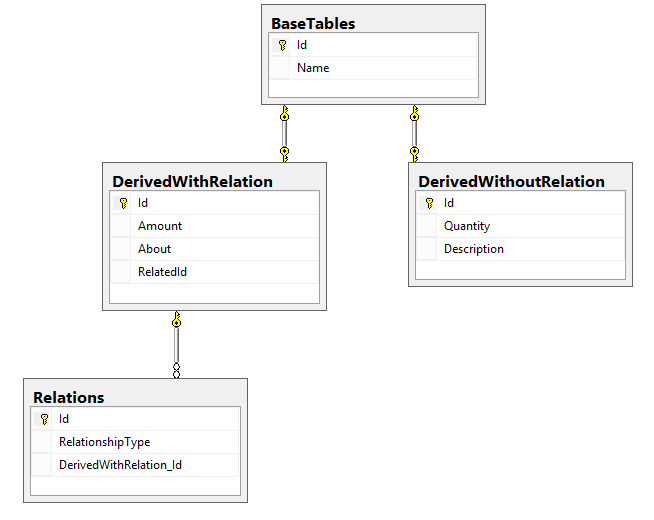Table Per Type (TPT) database using EntityFramework Code First
Recently @dot_Net_Junkie posted a question on StackOverflow on how to implement the TPT using EntityFramework. His original question was using a DB-First approach so my immediate thought was 'how about trying a code-first approach'. I set up a quick test project and this is how did it:
The models
public abstract class BaseTable
{
public int Id { get; set; }
public string Name { get; set; }
}
[Table("DerivedWithRelation")]
public class DerivedWithRelation : BaseTable
{
public int Amount { get; set; }
public string About { get; set; }
public int RelatedId { get; set; }
public virtual ICollection<Relation> Relations { get; set; }
}
[Table("DerivedWithoutRelation")]
public class DerivedWithoutRelation : BaseTable
{
public int Quantity { get; set; }
public string Description { get; set; }
}
public class Relation
{
public int Id { get; set; }
public string RelationshipType { get; set; }
public virtual DerivedWithRelation DerivedWithRelation { get; set; }
}
The context
public class MyContext : DbContext
{
public MyContext()
: base("DefaultConnection")
{
}
public IDbSet<BaseTable> BaseTables { get; set; }
public IDbSet<DerivedWithRelation> DerivedWithRelations { get; set; }
public IDbSet<DerivedWithoutRelation> DerivedWithoutRelations { get; set; }
}
Creating the Entity Framework code first migration
Running Add-Migration TPTCodeFirstTest -ProjectName MyProject.Data -StartUpProjectName MyProject.Data should create something similar to the following:
public partial class AddTPTTest : DbMigration
{
public override void Up()
{
CreateTable(
"dbo.BaseTables",
c => new
{
Id = c.Int(nullable: false, identity: true),
Name = c.String(),
})
.PrimaryKey(t => t.Id);
CreateTable(
"dbo.Relations",
c => new
{
Id = c.Int(nullable: false, identity: true),
RelationshipType = c.String(),
DerivedWithRelation_Id = c.Int(),
})
.PrimaryKey(t => t.Id)
.ForeignKey("dbo.DerivedWithRelation", t => t.DerivedWithRelation_Id)
.Index(t => t.DerivedWithRelation_Id);
CreateTable(
"dbo.DerivedWithRelation",
c => new
{
Id = c.Int(nullable: false),
Amount = c.Int(nullable: false),
About = c.String(),
RelatedId = c.Int(nullable: false),
})
.PrimaryKey(t => t.Id)
.ForeignKey("dbo.BaseTables", t => t.Id)
.Index(t => t.Id);
CreateTable(
"dbo.DerivedWithoutRelation",
c => new
{
Id = c.Int(nullable: false),
Quantity = c.Int(nullable: false),
Description = c.String(),
})
.PrimaryKey(t => t.Id)
.ForeignKey("dbo.BaseTables", t => t.Id)
.Index(t => t.Id);
}
public override void Down()
{
DropIndex("dbo.DerivedWithoutRelation", new[] { "Id" });
DropIndex("dbo.DerivedWithRelation", new[] { "Id" });
DropIndex("dbo.Relations", new[] { "DerivedWithRelation_Id" });
DropForeignKey("dbo.DerivedWithoutRelation", "Id", "dbo.BaseTables");
DropForeignKey("dbo.DerivedWithRelation", "Id", "dbo.BaseTables");
DropForeignKey("dbo.Relations", "DerivedWithRelation_Id", "dbo.DerivedWithRelation");
DropTable("dbo.DerivedWithoutRelation");
DropTable("dbo.DerivedWithRelation");
DropTable("dbo.Relations");
DropTable("dbo.BaseTables");
}
}
All that is left is to push our changes to the database
Update-Database -ProjectName MyProject.Data -StartUpProjectName MyProject.Data -Verbose
Et voila: The following database structure is created:

Hope that helps. If you found this useful, please share using the links at the start of this post.